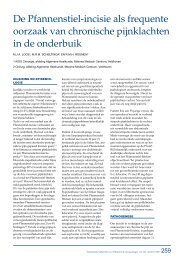Surgical management of chronic inguinal pain syndromes - Liespijn
Surgical management of chronic inguinal pain syndromes - Liespijn
Surgical management of chronic inguinal pain syndromes - Liespijn
You also want an ePaper? Increase the reach of your titles
YUMPU automatically turns print PDFs into web optimized ePapers that Google loves.
at the outpatient department as well (visit 2). Cross-over from the neurectomy to thenerve block group does not seem beneficial and is not included in the protocol.All patients receive a questionnaire by mail 3 and 6 months postoperatively. One yearpost-intervention, all participants are invited for final questionnaire assessment and aphysical examination at the surgical outpatient department (visit 3). Each patient willcomplete a <strong>Surgical</strong> Pain Scales 14 , McGill Pain Questionnaire - Dutch Language Version 15 ,SF-36 version II quality <strong>of</strong> life questionnaire at each follow-up moment 16 . At the outpatientdepartment visits (baseline, after 2 weeks, 12 months) the LANNS Pain scale, theLeeds Assessment <strong>of</strong> neuropathic <strong>pain</strong> and symptoms and signs, is completed 17 .Complications and change in employment status is noted at each post-interventionevaluation moment.Study endpointsThe primary endpoint is number <strong>of</strong> successfully treated patients with respect to <strong>pain</strong>reduction. Successful <strong>pain</strong> reduction is defined as a >50% <strong>pain</strong> reduction during restingconditions measured with the <strong>Surgical</strong> Pain Scales after 6 months. In case <strong>of</strong> necessityto cross-over from the nerve block group to the neurectomy group or if additionaltreatment like <strong>chronic</strong> <strong>pain</strong> medication remains necessary, this is considered a treatmentfailure.Secondary endpoints are quality <strong>of</strong> life (SF-36 version II), alterations in <strong>inguinal</strong> neurophysiologicalstatus (LANNS <strong>pain</strong> scale), complications (self-constructed questionnaire),and change in employment status (self-constructed questionnaire).Sample sizeA successful intervention is defined as a 50% reduction (Visual Analogue Scale) in rest<strong>pain</strong> (<strong>Surgical</strong> Pain Scales) after 6 months <strong>of</strong> follow-up. After a thorough study <strong>of</strong> theavailable literature, success rates <strong>of</strong> a nerve block appeared unknown. After a consultation<strong>of</strong> several <strong>of</strong> our anaesthesiologists specialized in the treatment <strong>of</strong> <strong>chronic</strong> <strong>pain</strong>, thesuccess rate <strong>of</strong> a nerve block is set at 25%. Based on retrospective cohort studies, thesuccess percentage following a surgical neurectomy approximates 75%. Using a type Ierror <strong>of</strong> 0.05 and type II error <strong>of</strong> 0.10, a sample size is calculated <strong>of</strong> 54 patients (2 groups<strong>of</strong> 27 patients).Statistical analysisIntention-to-treat analysis will be applied on the primary endpoint <strong>pain</strong> reduction. Sincewe expect a significant cross-over from the nerve block group towards the neurectomygroup, an ‘as treated analysis’ will be made as well. Endpoints will be analyzed per groupand at each evaluation time. Chi/square test is used for comparison <strong>of</strong> categoricalvariables. Quantitative variables will compared by Mann-Whitney U test. Results willbe considered significant if P≤ 0.05.DISCUSSIONIn recent years, a number <strong>of</strong> studies has stressed the importance <strong>of</strong> <strong>chronic</strong> <strong>pain</strong> as animportant complication after <strong>inguinal</strong> hernia repair 1-4 . However, to date only a fewstudies on treatment options such as operative neurectomy or therapeutic nerve blockshave been published. There is a definite need for more evidence-based treatment regimesin these populations. The present trial will be the first randomized study comparingtwo frequently used treatment modalities for <strong>chronic</strong> neuralgia after <strong>inguinal</strong> herniarepair.Populations with postherniorrhaphy <strong>pain</strong> <strong>syndromes</strong> are notoriously heterogeneous.Therefore, only patients with presumed peripheral <strong>inguinal</strong> nerve entrapment areincluded. In contrast, individuals with non-neuropathic <strong>pain</strong> (‘nociceptive’) includingperiostitis or folded or migrated fibrotic mesh material are not eligible as their <strong>pain</strong> isprobably unresponsive to an exclusive neurectomy 8 . Patients that will probably also notrespond to a tailored neurectomy are the ‘long-term neuropathic <strong>pain</strong> sufferers’, as theymay have developed sensitization <strong>of</strong> the central nervous system. Permanent sensitisationon cerebral level is thought to render peripheral interventions such as a neurectomyinsufficient 18 . Although these patients typically report symptomatology associated withneuropathic <strong>pain</strong>, peripheral nerve blocks will probably not induce <strong>pain</strong> reduction. Therefore,a substantial temporary <strong>pain</strong> reduction after <strong>inguinal</strong> nerve block with lidocainserves as an important prerequisite for inclusion in the present trial.There is little evidence on the beneficial effects <strong>of</strong> an injection <strong>of</strong> a cocktail <strong>of</strong> agents forthe treatment <strong>of</strong> <strong>chronic</strong> <strong>inguinal</strong> neuropathic <strong>pain</strong>. The choice for a combination <strong>of</strong>lidocain, corticosteroids and hyaluronic acid was made after consultation <strong>of</strong> several anaesthesiologist-<strong>pain</strong>specialists 19 . One study suggested that corticosteroids act by suppression<strong>of</strong> ectopic neural discharges from the injured nerve endings 6 . Moreover,hyaluronic acid may s<strong>of</strong>ten scar tissue and may aid in local infiltration <strong>of</strong> the anaestheticand corticosteroids 20 . It was hypothesized that the combination <strong>of</strong> these twosubstances acted synergistically and facilitated and potentiated the analgesic effects<strong>of</strong> lidocain.Although the sequence <strong>of</strong> steps in the surgical neurectomy is standardized as much aspossible, experience with past cases indicated that each patient requires individualization.Therefore, pre- and perioperative findings guided us on the handling <strong>of</strong> the affectednerves, ‘the tailored approach’ 12 . In contrast, a single specialist center advocates astandard ‘triple neurectomy’ for this <strong>pain</strong> syndrome, removing all three <strong>inguinal</strong> nervesduring one procedure , achieving success rates up to 85%. However, slightly lower successrates for this difficult <strong>chronic</strong> <strong>pain</strong> issue are probably more realistic, which we havedemonstrated in a recently published retrospective review on the ‘tailored approach’.The latter patient cohort exhibited a more heterogeneous <strong>pain</strong> pattern (e.g. alsonon-neuropathic) and had <strong>of</strong>ten received surgical interventions in other clinics as well.102 Chapter 7Randomized controlled trial <strong>of</strong> neurectomy versus injection with lidocain, corticosteroids... 103





